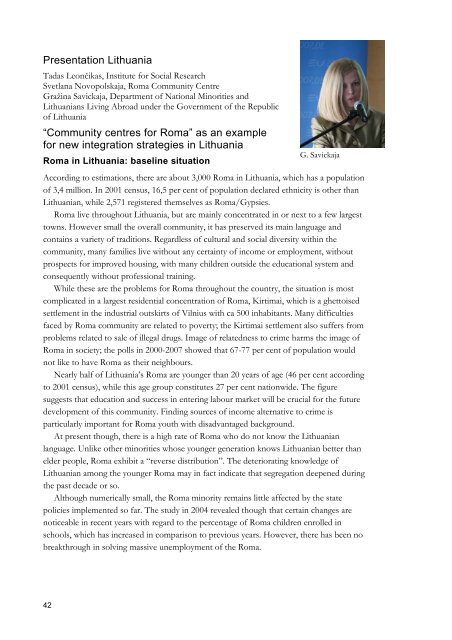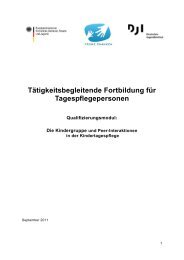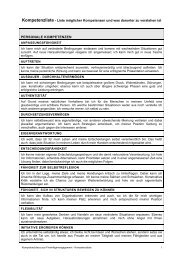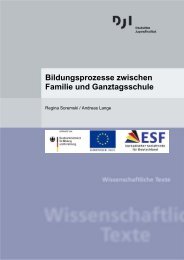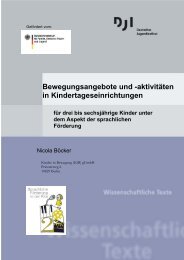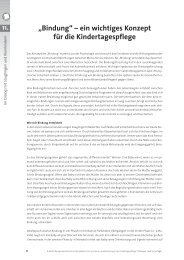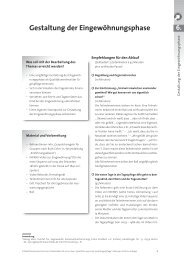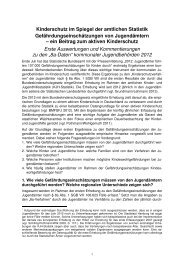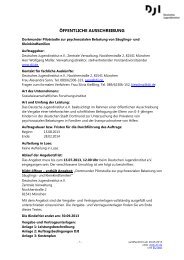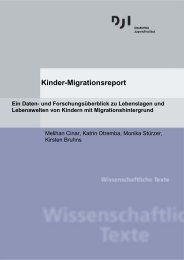download - Deutsches Jugendinstitut e.V.
download - Deutsches Jugendinstitut e.V.
download - Deutsches Jugendinstitut e.V.
You also want an ePaper? Increase the reach of your titles
YUMPU automatically turns print PDFs into web optimized ePapers that Google loves.
Presentation Lithuania<br />
Tadas Leončikas, Institute for Social Research<br />
Svetlana Novopolskaja, Roma Community Centre<br />
Gražina Savickaja, Department of National Minorities and<br />
Lithuanians Living Abroad under the Government of the Republic<br />
of Lithuania<br />
“Community centres for Roma” as an example<br />
for new integration strategies in Lithuania<br />
Roma in Lithuania: baseline situation<br />
G. Savickaja<br />
According to estimations, there are about 3,000 Roma in Lithuania, which has a population<br />
of 3,4 million. In 2001 census, 16,5 per cent of population declared ethnicity is other than<br />
Lithuanian, while 2,571 registered themselves as Roma/Gypsies.<br />
Roma live throughout Lithuania, but are mainly concentrated in or next to a few largest<br />
towns. However small the overall community, it has preserved its main language and<br />
contains a variety of traditions. Regardless of cultural and social diversity within the<br />
community, many families live without any certainty of income or employment, without<br />
prospects for improved housing, with many children outside the educational system and<br />
consequently without professional training.<br />
While these are the problems for Roma throughout the country, the situation is most<br />
complicated in a largest residential concentration of Roma, Kirtimai, which is a ghettoised<br />
settlement in the industrial outskirts of Vilnius with ca 500 inhabitants. Many difficulties<br />
faced by Roma community are related to poverty; the Kirtimai settlement also suffers from<br />
problems related to sale of illegal drugs. Image of relatedness to crime harms the image of<br />
Roma in society; the polls in 2000-2007 showed that 67-77 per cent of population would<br />
not like to have Roma as their neighbours.<br />
Nearly half of Lithuania’s Roma are younger than 20 years of age (46 per cent according<br />
to 2001 census), while this age group constitutes 27 per cent nationwide. The figure<br />
suggests that education and success in entering labour market will be crucial for the future<br />
development of this community. Finding sources of income alternative to crime is<br />
particularly important for Roma youth with disadvantaged background.<br />
At present though, there is a high rate of Roma who do not know the Lithuanian<br />
language. Unlike other minorities whose younger generation knows Lithuanian better than<br />
elder people, Roma exhibit a “reverse distribution”. The deteriorating knowledge of<br />
Lithuanian among the younger Roma may in fact indicate that segregation deepened during<br />
the past decade or so.<br />
Although numerically small, the Roma minority remains little affected by the state<br />
policies implemented so far. The study in 2004 revealed though that certain changes are<br />
noticeable in recent years with regard to the percentage of Roma children enrolled in<br />
schools, which has increased in comparison to previous years. However, there has been no<br />
breakthrough in solving massive unemployment of the Roma.<br />
42


